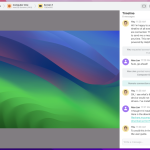Health care services’ providers, particularly the home care agencies, are finding an easy way out through the use of home care software, which has quickly become an integral part of care delivery. This technology has been customized to address the distinct needs of homes, including scheduling requirements, recording practice documentation, compliance, and interaction with clients.
Key Benefits of Modern Home Care Software
State-of-the-art home care software AlayaCare, for example, is very user-friendly and offers a fresh perspective on the way agencies function, namely:
Streamlined Operations
Streamlined home care software workflows are developed the same way with the aim of making agency tasks more comprehensive. Agencies are able to carry out less paperwork and attend to fewer manual processes, with offices streamlining scheduling, documentation, and administrative tasks through electronic means. This combined approach ensures a streamlined approach that targets the administrative aspects and frees staff to concentrate more on service delivery.
Today’s solutions offer reliable real-time data access, which caregivers can use to make informed decisions during their in-service time. This real-time access to client data and care warrants congruence of care provided and reduces the time required to respond to altered client requirements.
Enhanced Scheduling Capabilities
Efficient scheduling is critical in home care delivery. Advanced home care software includes features like:
- SMS notifications for shift changes
- Easy shift acceptance through mobile apps
- Optimization tools to balance workloads
- Automated matching of caregiver skills to client needs
These capabilities reduce scheduling conflicts, minimize travel time, and ensure appropriate staffing levels.
Data-Driven Decision Making
Veteran home care providers have almost unrivaled abilities to identify the opportunities that can easily translate into data. To start with, such organizations can look at:
- Monitor trends across their organization
- Identify inefficiencies in service delivery
- Track compliance metrics
- Analyze financial performance indicators
Utilizing such information empowers the organizations to make informed decisions and allocate better resources for desired goals and improvements in areas such as top-line growth and process management. This would improve the value of all these key metrics of the organization.
Mobile Accessibility
Modern home care software is designed for mobility, recognizing that caregivers need access to information while in clients’ homes. Mobile applications allow for:
- Real-time documentation at the point of care
- Access to care plans and medical histories
- Secure messaging with the office staff
- Electronic visit verification compliance
This mobility ensures caregivers have the tools they need, regardless of location.
Integration Capabilities
No technology exists in isolation. Leading home care software solutions offer integration with other systems through secure APIs. This connectivity allows agencies to build a comprehensive technology ecosystem that includes:
- Electronic health records
- Billing systems
- HR and payroll platforms
- Medication databases
- Client engagement tools
Evaluating Home Care Software Solutions
When selecting home care software, agencies should consider several factors:
- Scalability: Can the system grow with your agency?
- Compliance: Does it meet regulatory requirements like HIPAA and EVV?
- User Experience: Is it intuitive for both office staff and caregivers?
- Support: What level of implementation and ongoing assistance is provided?
- Cost Structure: Is pricing transparent and aligned with your business model?
The Future of Home Care Software
New trends in technology have made it possible to integrate homecare software with even more functionality, now such as advanced artificial intelligence assistants, predictive analytics, and improved client engagement tools. Agencies that employ these new technologies find them not only actionable but also able to strategize on emerging healthcare dynamics.
For organizations that are still practicing manual processes or have obsolete systems, implementing new home care software is a chance to increase efficiency and improve service delivery. Better tools for caregivers, together with comprehensive information provided by these systems and solutions, result in improved client satisfaction and outcomes.
Lynn Martelli is an editor at Readability. She received her MFA in Creative Writing from Antioch University and has worked as an editor for over 10 years. Lynn has edited a wide variety of books, including fiction, non-fiction, memoirs, and more. In her free time, Lynn enjoys reading, writing, and spending time with her family and friends.















